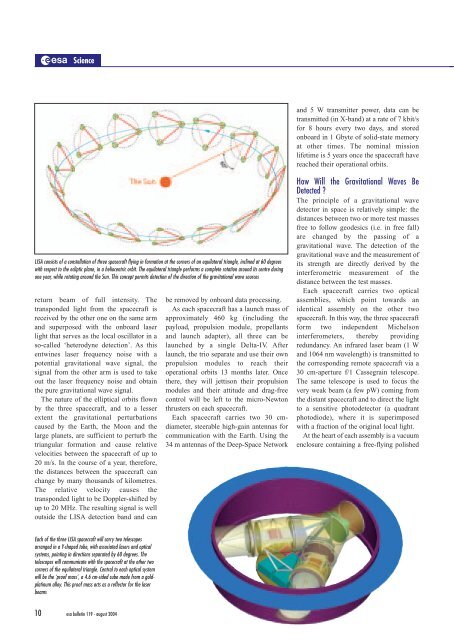Gravitational Waves and Massive Black Holes? – The LISA
Gravitational Waves and Massive Black Holes? – The LISA
Gravitational Waves and Massive Black Holes? – The LISA
You also want an ePaper? Increase the reach of your titles
YUMPU automatically turns print PDFs into web optimized ePapers that Google loves.
Science<br />
<strong>LISA</strong> consists of a constellation of three spacecraft flying in formation at the corners of an equilateral triangle, inclined at 60 degrees<br />
with respect to the ecliptic plane, in a heliocentric orbit. <strong>The</strong> equilateral triangle performs a complete rotation around its centre during<br />
one year, while rotating around the Sun. This concept permits detection of the direction of the gravitational wave sources<br />
return beam of full intensity. <strong>The</strong><br />
transponded light from the spacecraft is<br />
received by the other one on the same arm<br />
<strong>and</strong> superposed with the onboard laser<br />
light that serves as the local oscillator in a<br />
so-called ‘heterodyne detection’. As this<br />
entwines laser frequency noise with a<br />
potential gravitational wave signal, the<br />
signal from the other arm is used to take<br />
out the laser frequency noise <strong>and</strong> obtain<br />
the pure gravitational wave signal.<br />
<strong>The</strong> nature of the elliptical orbits flown<br />
by the three spacecraft, <strong>and</strong> to a lesser<br />
extent the gravitational perturbations<br />
caused by the Earth, the Moon <strong>and</strong> the<br />
large planets, are sufficient to perturb the<br />
triangular formation <strong>and</strong> cause relative<br />
velocities between the spacecraft of up to<br />
20 m/s. In the course of a year, therefore,<br />
the distances between the spacecraft can<br />
change by many thous<strong>and</strong>s of kilometres.<br />
<strong>The</strong> relative velocity causes the<br />
transponded light to be Doppler-shifted by<br />
up to 20 MHz. <strong>The</strong> resulting signal is well<br />
outside the <strong>LISA</strong> detection b<strong>and</strong> <strong>and</strong> can<br />
Each of the three <strong>LISA</strong> spacecraft will carry two telescopes<br />
arranged in a Y-shaped tube, with associated lasers <strong>and</strong> optical<br />
systems, pointing in directions separated by 60 degrees. <strong>The</strong><br />
telescopes will communicate with the spacecraft at the other two<br />
corners of the equilateral triangle. Central to each optical system<br />
will be the ‘proof mass’, a 4.6 cm-sided cube made from a goldplatinum<br />
alloy. This proof mass acts as a reflector for the laser<br />
beams<br />
10 esa bulletin 119 - august 2004<br />
be removed by onboard data processing.<br />
As each spacecraft has a launch mass of<br />
approximately 460 kg (including the<br />
payload, propulsion module, propellants<br />
<strong>and</strong> launch adapter), all three can be<br />
launched by a single Delta-IV. After<br />
launch, the trio separate <strong>and</strong> use their own<br />
propulsion modules to reach their<br />
operational orbits 13 months later. Once<br />
there, they will jettison their propulsion<br />
modules <strong>and</strong> their attitude <strong>and</strong> drag-free<br />
control will be left to the micro-Newton<br />
thrusters on each spacecraft.<br />
Each spacecraft carries two 30 cmdiameter,<br />
steerable high-gain antennas for<br />
communication with the Earth. Using the<br />
34 m antennas of the Deep-Space Network<br />
<strong>and</strong> 5 W transmitter power, data can be<br />
transmitted (in X-b<strong>and</strong>) at a rate of 7 kbit/s<br />
for 8 hours every two days, <strong>and</strong> stored<br />
onboard in 1 Gbyte of solid-state memory<br />
at other times. <strong>The</strong> nominal mission<br />
lifetime is 5 years once the spacecraft have<br />
reached their operational orbits.<br />
How Will the <strong>Gravitational</strong> <strong>Waves</strong> Be<br />
Detected ?<br />
<strong>The</strong> principle of a gravitational wave<br />
detector in space is relatively simple: the<br />
distances between two or more test masses<br />
free to follow geodesics (i.e. in free fall)<br />
are changed by the passing of a<br />
gravitational wave. <strong>The</strong> detection of the<br />
gravitational wave <strong>and</strong> the measurement of<br />
its strength are directly derived by the<br />
interferometric measurement of the<br />
distance between the test masses.<br />
Each spacecraft carries two optical<br />
assemblies, which point towards an<br />
identical assembly on the other two<br />
spacecraft. In this way, the three spacecraft<br />
form two independent Michelson<br />
interferometers, thereby providing<br />
redundancy. An infrared laser beam (1 W<br />
<strong>and</strong> 1064 nm wavelength) is transmitted to<br />
the corresponding remote spacecraft via a<br />
30 cm-aperture f/1 Cassegrain telescope.<br />
<strong>The</strong> same telescope is used to focus the<br />
very weak beam (a few pW) coming from<br />
the distant spacecraft <strong>and</strong> to direct the light<br />
to a sensitive photodetector (a quadrant<br />
photodiode), where it is superimposed<br />
with a fraction of the original local light.<br />
At the heart of each assembly is a vacuum<br />
enclosure containing a free-flying polished

















